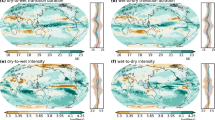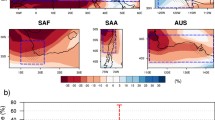Abstract
Heavy precipitation exerts strong societal and economic impacts, including flooding, and these precipitation events are projected to increase under anthropogenic warming. The United Nations Framework Convention on Climate Change (UNFCCC) Paris Agreement signed in December 2015 aims to limit the global average temperature rise to below 2 °C above preindustrial levels, with an added goal of limiting temperature increases to 1.5 °C. There remains a major knowledge gap related to our understanding of changes in heavy precipitation under the 1.5 and 2 °C warming targets. Here, we investigate the changes in heavy precipitation events with the Community Earth System Model (CESM) climate experiments using the scenarios consistent with the 1.5 and 2 °C temperature targets. We find that the frequency of annual heavy precipitation at a global scale increases in both 1.5 and 2 °C scenarios until around 2070, after which the magnitudes of the trend become much weaker or even negative. Overall, the annual frequency of heavy precipitation across the globe is similar between 1.5 and 2 °C for the period 2006–2035, and the changes in heavy precipitation in individual seasons are consistent with those for the entire year. The frequency of heavy precipitation in the 2 °C experiments is higher than for the 1.5 °C experiment after the late 2030s, particularly for the period 2071–2100. While the results of both experiments indicate that the warming targets in the Paris Agreement, if met, would be effective in reducing the frequency of heavy precipitation (2 °C target minus 1.5 °C target), they also suggest a lower risk of global heavy precipitation under the 1.5 °C target of about 33% for the period 2071–2100.



Similar content being viewed by others
References
Alexander LV et al (2006) Global observed changes in daily climate extremes of temperature and precipitation. J Geophys Res: Atmos:111. https://doi.org/10.1029/2005JD006290
Allen MR, Ingram WJ (2002) Constraints on future changes in climate and the hydrologic cycle. Nature 419:224–232
Boucher O et al (2016) Opinion: in the wake of Paris Agreement, scientists must embrace new directions for climate change research. Proc Natl Acad Sci 113:7287–7290
Cheung WWL, Reygondeau G, Frölicher TL (2016) Large benefits to marine fisheries of meeting the 1.5°C global warming target. Science 354:1591–1594
Donat MG, Alexander LV, Yang H, Durre I, Vose R, Dunn RJH et al (2013) Updated analyses of temperature and precipitation extreme indices since the beginning of the twentieth century: the HadEX2 dataset. J Geophys Res: Atmos 118(5):2098–2118. https://doi.org/10.1002/jgrd.50150
Donat MG, Lowry AL, Alexander LV, Ogorman PA, Maher N (2016) More extreme precipitation in the world’s dry and wet regions. Nat Clim Change 6:508–513
Easterling DR, Meehl GA, Parmesan C, Changnon SA, Karl TR, Mearns LO (2000) Climate extremes: observations, modeling, and impacts. Science 289:2068–2074
Fischer EM, Knutti R (2015) Anthropogenic contribution to global occurrence of heavy-precipitation and high-temperature extremes. Nat Clim Chang 5:560–564
Fischer EM, Knutti R (2016) Observed heavy precipitation increase confirms theory and early models. Nat Clim. Change 6:986–991
Fischer EM, Beyerle U, Knutti R (2013) Robust spatially aggregated projections of climate extremes. Nat Clim Change 3:1033–1038
Frieler K, Meinshausen M, Golly A, Mengel M, Lebek K, Donner SD, Hoegh-Guldberg O (2013) Limiting global warming to 2°C is unlikely to save most coral reefs. Nat Clim Change 3:165–170
Frieler K et al (2016) Assessing the impacts of 1.5°C global warming—simulation protocol of the Inter-Sectoral Impact Model Intercomparison Project (ISIMIP2b). Geosci Model Dev Discuss 2016:1–59
Fulton EA (2016) A stitch in time saves nine…billion. Science 354:1530–1531
Guiot J, Cramer W (2016) Climate change: the 2015 Paris Agreement thresholds and Mediterranean basin ecosystems. Science 354:465–468
Held IM, Soden BJ (2006) Robust responses of the hydrological cycle to global warming. J Clim 19:5686–5699
Houghton JT (1996) Climate change 1995: the science of climate change: contribution of working group I to the second assessment report of the Intergovernmental Panel on Climate Change, vol 2. Cambridge University Press, Cambridge
Hulme M (2016) 1.5 °C and climate research after the Paris Agreement. Nature Clim Change 6:222–224
James R, Washington R, Schleussner C-F, Rogelj J, Conway D (2017) Characterizing half-a-degree difference: a review of methods for identifying regional climate responses to global warming targets. Wiley Interdiscip Rev Clim Chang 8:e457
Karmalkar AV, Bradley RS (2017) Consequences of global warming of 1.5 °C and 2 °C for regional temperature and precipitation changes in the contiguous United States. PLoS One 12:e0168697
Kay JE et al (2015) The Community Earth System Model (CESM) Large Ensemble Project: a community resource for studying climate change in the presence of internal climate variability. Bull Am Meteorol Soc 96:1333–1349
Kharin VV, Zwiers FW, Zhang X, Wehner M (2013) Changes in temperature and precipitation extremes in the CMIP5 ensemble. Clim Chang 119:345–357
Knutti R, Rogelj J, Sedláček J, Fischer EM (2016) A scientific critique of the two-degree climate change target. Nat Geosci 9:13–18
Lissner TK, Fischer EM (2016) Differential climate impacts for policy-relevant limits to global warming: the case of 1.5-° C and 2-° C. Earth Syst Dyn 7:327
Min S-K, Zhang X, Zwiers FW, Hegerl GC (2011) Human contribution to more-intense precipitation extremes. Nature 470:378–381
Mitchell D, James R, Forster PM, Betts RA, Shiogama H, Allen M (2016) Realizing the impacts of a 1.5 °C warmer world. Nature Clim Change 6:735–737
O'Gorman PA, Schneider T (2009) The physical basis for increases in precipitation extremes in simulations of 21st-century climate change. Proc Natl Acad Sci 106:14773–14777
O'Gorman PA (2012) Sensitivity of tropical precipitation extremes to climate change. Nat Geosci 5:697–700
Peters GP (2016) The ‘best available science’ to inform 1.5 °C policy choices. Nat Clim Change 6:646–649
Sanderson BM, O’Neill BC, Tebaldi C (2016) What would it take to achieve the Paris temperature targets? Geophys Res Lett 43:7133–7142
Sanderson BM, Xu Y, Tebaldi C, Wehner M, O'Neill B, Jahn A et al (2017) Community Climate Simulations to assess avoided impacts in 1.5°C and 2°C futures. Earth Syst Dyn Discus 2017:1–33. https://doi.org/10.5194/esd-2017-42
Scoccimarro E, Villarini G, Vichi M, Zampieri M, Fogli PG, Bellucci A, Gualdi S (2015) Projected changes in intense precipitation over Europe at the daily and subdaily time Scales. J Clim 28(15):6193–6203. https://doi.org/10.1175/jcli-d-14-00779.1
Scoccimarro E, Gualdi S, Bellucci A, Zampieri M, Navarra A (2016) Heavy precipitation events over the Euro-Mediterranean region in a warmer climate: results from CMIP5 models. Reg Environ Chang 16(3):595–602. https://doi.org/10.1007/s10113-014-0712-y
Secretariat, U., 2015: Report on the structured expert dialogue on the 2013–2015 review. United Nations Office at Geneva
Seneviratne SI, Donat MG, Pitman AJ, Knutti R, Wilby RL (2016) Allowable CO2 emissions based on regional and impact-related climate targets. Nature 529(7587):477–483
Sillmann J, Kharin VV, Zhang X, Zwiers FW, Bronaugh D (2013) Climate extremes indices in the CMIP5 multimodel ensemble: part 1. Model evaluation in the present climate. J Geophys Res: Atmos 118:1716–1733
Stocker, T. F., D. Qin, G.-K. Plattner, M. Tignor, S. K. Allen, J. Boschung, A. Nauels, Y. Xia, B. Bex, and B. Midgley, 2013: IPCC, 2013: climate change 2013: the physical science basis. Contribution of working group I to the fifth assessment report of the intergovernmental panel on climate change, edited, Cambridge: Cambridge University Press
UNFCCC, 2015: Report on the Structured Expert Dialogue on the 2013–2015 Review FCCC/SB/2015/INF.1
van der Wiel K, Kapnick SB, Vecchi GA, Cooke WF, Delworth TL, Jia L, Murakami H, Underwood S, Zeng F (2016) The resolution dependence of contiguous U.S. precipitation extremes in response to CO2 forcing. J Climate 29:7991–8012 https://doi.org/10.1175/JCLI-D-16-0307.1
Westra S, Alexander LV, Zwiers FW (2013) Global increasing trends in annual maximum daily precipitation. J Clim 26:3904–3918
Zhang W, Villarini G, Scoccimarro E, Vecchi GA (2017) Stronger influences of increased CO2 on subdaily precipitation extremes than at the daily scale. Geophys Res Lett 44(14):7464–7471. https://doi.org/10.1002/2017GL074024
Zhang X, Wan H, Zwiers FW, Hegerl GC, Min S-K (2013) Attributing intensification of precipitation extremes to human influence. Geophys Res Lett 40:5252–5257
Acknowledgments
We appreciate two anonymous reviewers for insightful comments which improved the quality of this paper. This material is based upon work supported in part by the Broad Agency Announcement Program and the Engineer Research and Development Center–Cold Regions Research and Engineering Laboratory under Contract W913E5-16-C-0002, the National Science Foundation under CAREER Grant AGS-1349827, IIHR-Hydroscience & Engineering, and the Iowa Flood Center. We gratefully acknowledge Rhawn Denniston’s guidance and suggestions.
Author information
Authors and Affiliations
Corresponding author
Electronic supplementary material
ESM 1
(DOCX 10216 kb)
Rights and permissions
About this article
Cite this article
Zhang, W., Villarini, G. Heavy precipitation is highly sensitive to the magnitude of future warming. Climatic Change 145, 249–257 (2017). https://doi.org/10.1007/s10584-017-2079-9
Received:
Accepted:
Published:
Issue Date:
DOI: https://doi.org/10.1007/s10584-017-2079-9




